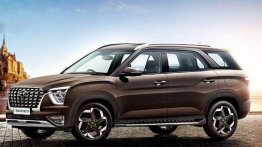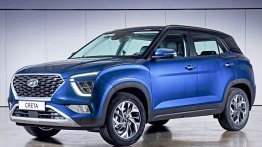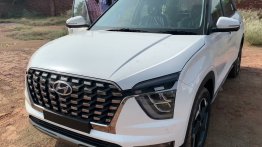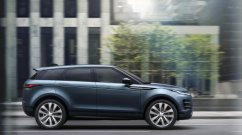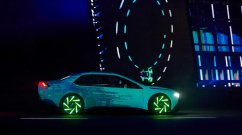Since the launch of the Hyundai Creta, the average cost of a Hyundai car sold in India has shot up to nearly INR 8 lakhs from the previous INR 4-5 lakhs, a clear indication that the brand's 'modern-premium' appeal has indeed garnered the right audience. Hyundai India's launches this year, the 2016 Hyundai Elantra and the forthcoming 2016 Hyundai Tucson, only add testament to that changing brand image, as these are products that are positioned towards the top of the pyramid.
The Hyundai India management has already set its goal of the Elantra leading its segment, with planned sales in the region of 300-350 units/month. That is indeed a tall order given that this segment contributed to only 1,111 units in the month of August 2016. So, is the Elantra really that good, or is the company building castles in the air?
Exterior:
Hyundai is not the manufacturer to give subtle design updates to its models. The above image is from the Elantra's brochure and one thing is pretty clear. At no point has the Elantra gone through an evolutionary or a mild design upgrade; with each generation designers have only taken the revolutionary route and experimented with something new. This has of course worked wonders with the previous 5th generation Elantra which, despite nearing its end-of-lifecycle, figured in the list of world's best selling cars for H1 2016 at number 6.
The 2016 Elantra which follows the brand's Fluidic Design V2.0 language is sleek, if one had to describe it in a word. The front end appears pretty low-slung courtesy of the pronounced hexagonal grille and the thin headlight clusters with L-shaped LED daytime running lights (Hello Jaguar XE!!). Over to the sides, the Elantra sports a rather attractive coupe-inspired roofline, which ends at gorgeous LED taillights, which look pretty special post sundown. We can't help but think the Elantra looks best from the rear angle.
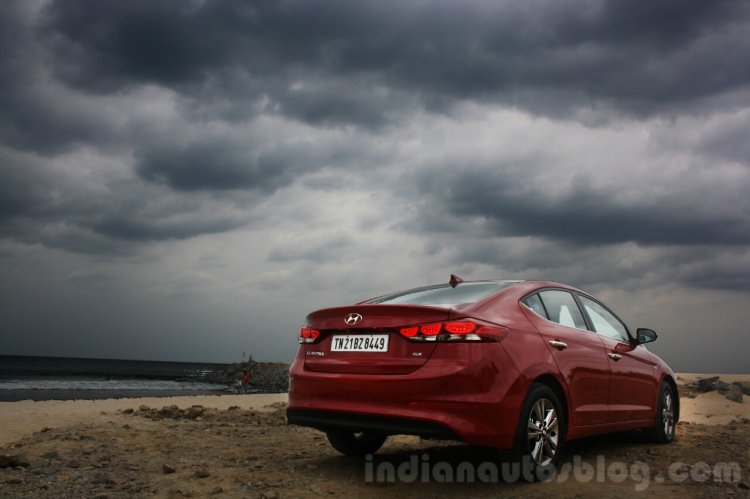
If one had to compare this segment to suits, the Corolla Altis is your typical double breast, the Jetta and the Octavia are well-tailored German suits, whereas the Elantra has just that amount of extra flamboyance to be an Italian suit.
At the tape, the 2016 Elantra measures 4,570 mm in length, 1,800 mm in width, 1,465 mm in height and 2,700 mm in wheelbase.
Interior:
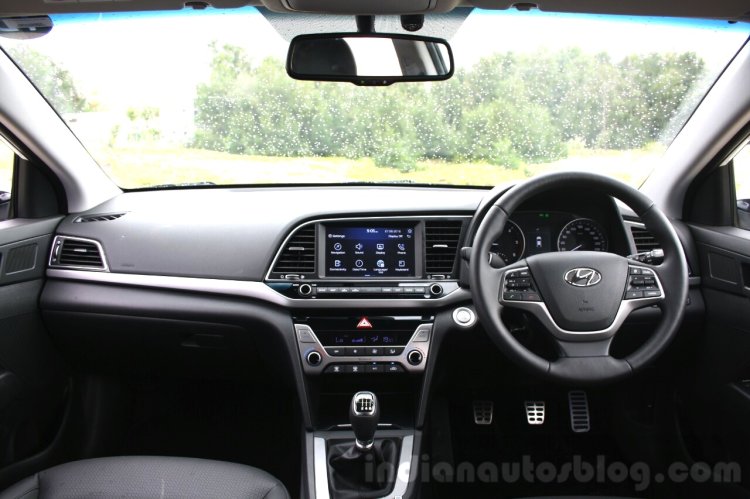
The 2016 Elantra has an interior which is made of well-built materials for the most part. Our grouse is with the color choice and design of the dashboard which doesn't look very special or premium. The instrument cluster and steering wheel for example, remind one of the Hyundai i20, whereas the silver accents used on the center console do not exude premium.
The interior is definitely a step-up from the previous generation Elantra, no doubt about that. However, experiencing products like the i20 and Creta made us expect more in terms of design and execution. However, once you're sat in the new Elantra, you tend to zone out thanks to the sheer comfort levels of the seats. The front seats in the top-end variant, with ventilation, could possibly make us choose the Elantra over a comfortable couch, its genuinely that comforting to have your behinds cooled in a manner that no La-Z Boy can! Its a shame this feature is restricted to the top-end SX (O) AT.
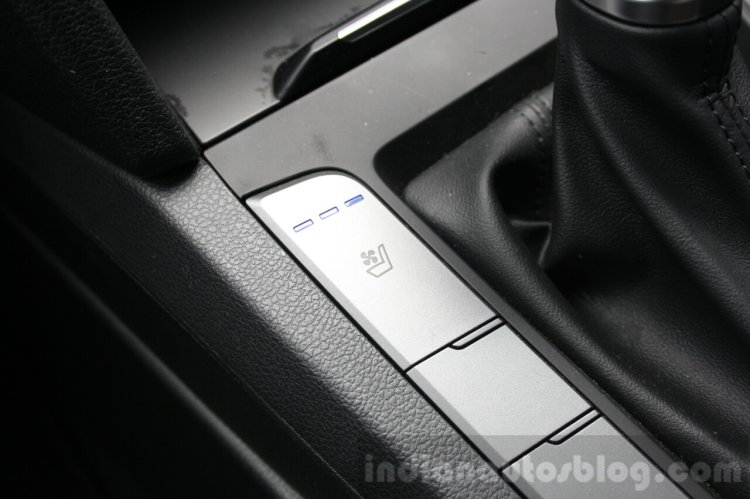
Aside from that, the overall visibility and access to the center console are pretty much bang-on from the front. However, the highlight of the Elantra's interior is at the rear. The seats are supremely comfortable and the angle of the backrest is near-perfect. Legroom is more than adequate for 6-footers seated front and back, though the headroom, owing to the coupe-ish silhouette, could prove to be tight if you're freakishly tall.
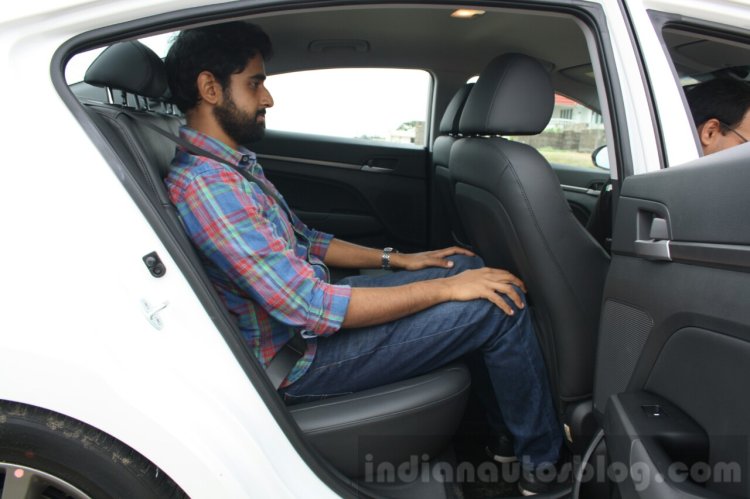
In the same week of the Elantra's drive, this journalist also drove a new luxury car. Though the luxury car in question costs more than double, its the Elantra this journalist would pick if he had to choose comfortable seating, especially at the rear.
Features:
While dual front airbags, ABS with EBD, front and rear disc brakes, automatic headlight control are part of the standard equipment list, only the top-end SX (O) AT variant offers side and curtain airbags, ESP, and vehicle stability management (VSM).
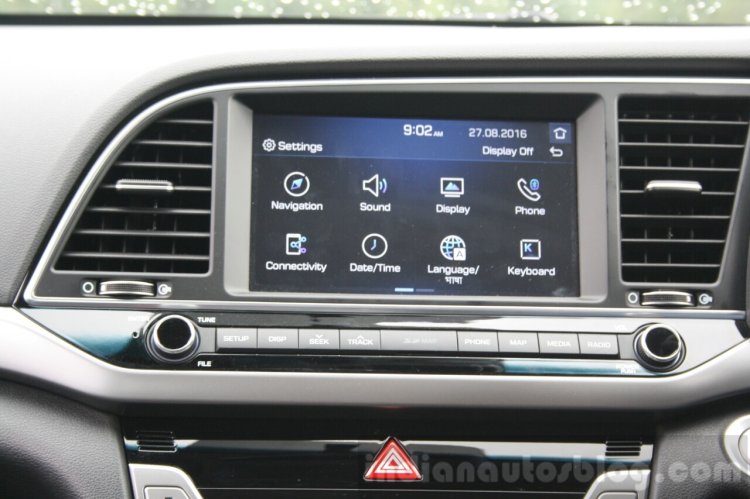
This variant also receives an electric sunroof, HID headlights, leatherette seats, 10-way electrically-adjustable driver’s seat, dual-zone climate control, ventilated front seats, 8.0-inch touchscreen entertainment system with Apple CarPlay and Android Auto, Arkamys sound system, leatherette seats, cruise control, rear parking camera and the innovative smart trunk (which automatically opens the trunk if it senses the owner standing within 3 feet behind it for more than 3 seconds).
Engine and Gearbox:
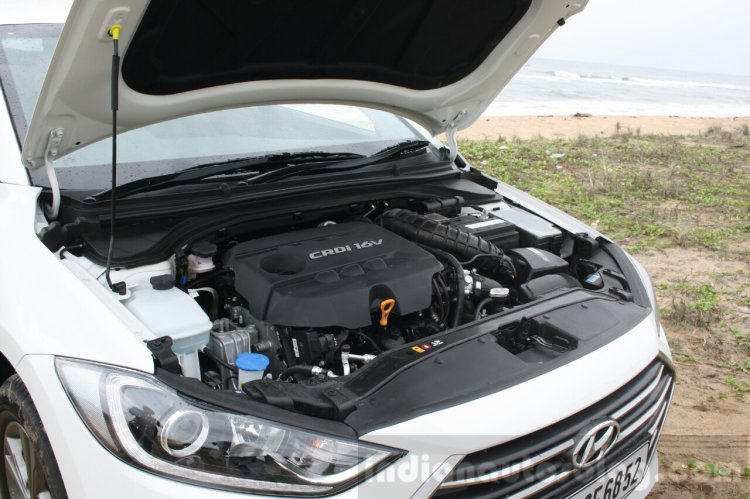
For the Indian market, the 2016 Elantra is available with a 2.0-liter Nu four-cylinder petrol engine and a 1.6-liter U2 CRDi diesel engine, the latter being a familiar unit from the Hyundai Creta and Verna. Engineers have however retuned this engine to suit a more relaxed driving nature though.
The diesel engine develops 128 PS at 4,000 rpm and 265 Nm of torque between 1,900-2,750 rpm and is paired to 6-speed manual or automatic transmissions. The more advanced 7-speed dual-clutch unit, offered currently in Korea, would have proven to be expensive for the Indian market, a company executive said.
We first sampled the diesel MT, and were left with a neutral review. This engine is not the most powerful in the segment, and clearly Hyundai is not pitching it that way either. Outright acceleration is more of a gentle tug, rather than 'pin your chest to the seat' kind. As our entire test drive route was the East Coast Road Highway connecting Chennai to Pondicherry, we can tell you very little about the bumper-to-bumper driving characteristics of this unit.
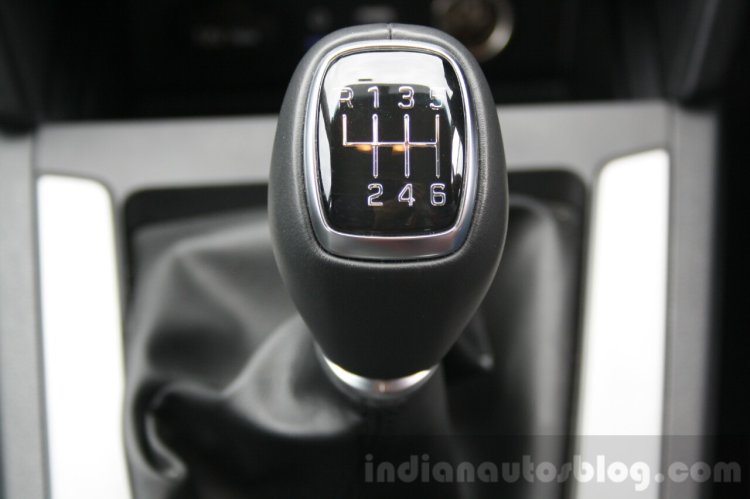
On the highway though, the Elantra diesel MT was able to attain speeds of up to 140 km/h while feeling planted, though speeds beyond that do highlight the fact that the Elantra is not as sure-footed as the Octavia or Jetta. One thing is for sure though, the Elantra diesel feels extremely refined, though one can say that about any modern-day Hyundai diesel-engined vehicle.
The diesel AT which we drove next felt as refined and quiet as the diesel MT but noticeably slower. Again, the emphasis is on relaxed and unhurried driving. The 6-speed single-clutch transmission is a smooth shifter and does a marvellous job when driven with a light to moderate throttle. As with a single-clutch transmission, down-shifting isn't as quick, though you do have the option of using the tiptronic feature.
Like the diesel MT, the diesel AT doesn't feel terribly quick; in fact, the AT feels a second or two slower than the MT, but this shouldn't be a problem for the urban user.
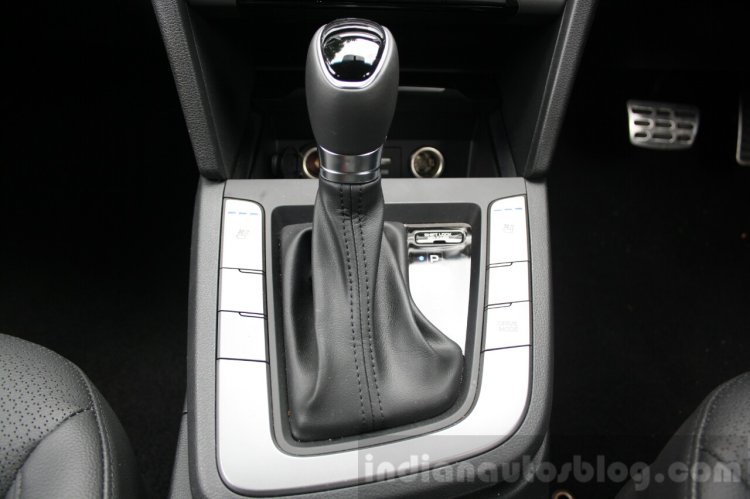
We got to sample only the petrol AT, which honestly didn't feel as nice to drive as the diesel variants. The 2.0-liter unit, despite being the largest engine in this segment, is neither-here-nor-there when it comes to performance. It makes 152 PS at 6,200 rpm and 196 Nm of torque at 4,000 rpm, which honestly can be described as average figures.
At low revs, the Elantra petrol doesn't feel all that different from driving a Verna 1.6 petrol, which is to say that its not very slow, but one could be at disbelief about the engine's larger displacement. While the speed builds up with revs, its not particularly quick as the 150 PS would suggest it to be. The 1.8-liter Corolla Altis with a CVT certainly feels spright-ier, whereas the TSI variants of the Jetta and Octavia are in a different league altogether.
Again, we couldn't experience this engine in urban conditions, and on the highway, it seems adequate to cruise at triple-digit speeds. The self-driven enthusiast though will have to look elsewhere in the segment, that's for certain.
Ride and Handling:
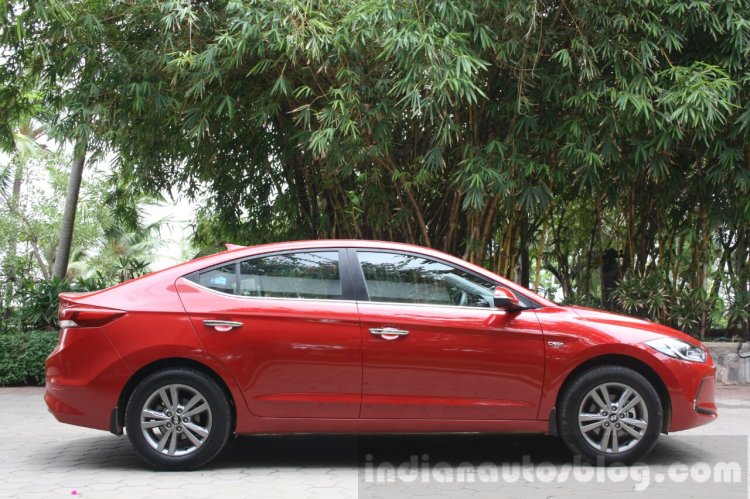
Coming to the handling part, great news here as engineers have made progress in leaps and bounds. To begin with, the 2016 Hyundai Elantra is made out of 53 percent advanced high-strength steel as compared to its predecessor's 21 percent. The increased rigidity levels were noticeable as soon as we hit the first corner on our test route.
The dynamics of the sedan are a massive improvement over its predecessor; the new Elantra feels sure-footed while taking corners even at speeds of 90-100 km/h. While the Elantra is no Octavia or Jetta in the handling department, it inspires so much driving confidence on the highways over the outgoing model and that's saying a lot.
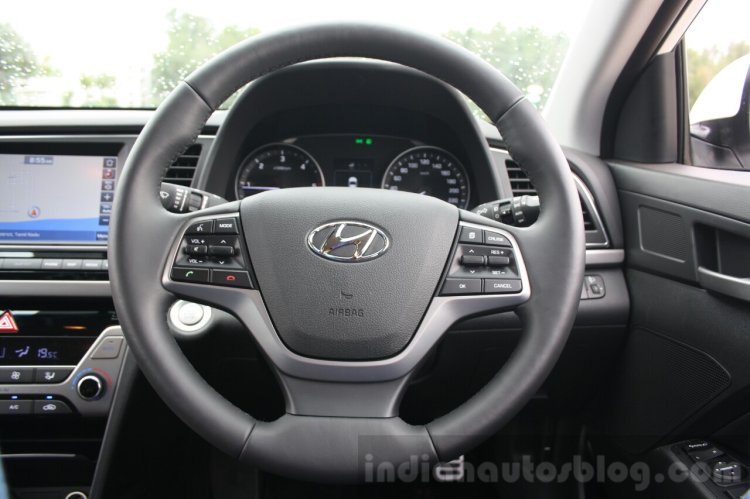
Gripes? The steering could use a lot more feedback, and the suspension at the rear could have been made a bit stiffer, but we're nitpicking here. The current setup should be more than adequate for the family-buyer or the chauffeur-driven owner.
We couldn't check the ride quality of the Elantra over poor roads owing to the flat surface of the East Coast Road highway. However, what this route did prove was the ride of the Elantra is pliant even at triple digit speeds; the predecessor felt bouncier.
Brakes and Safety:
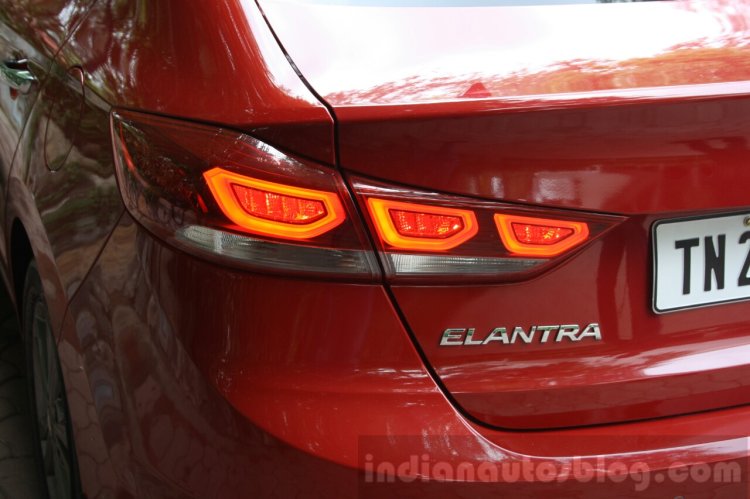
The 2016 Hyundai Elantra is shod with 205/60 16-inch tyres, however all variants get ABS, EBD and disc brakes at the front and rear. While braking performance of the car is adequate, under hard braking, the rear of the sedan feels a tad uneasy, and feels like it wants to break traction.
Though dual front airbags are standardized on the Elantra, one has to opt for the top-end SX (O) AT to avail six airbags. In this segment, Hyundai could have introduced side and curtain airbags in the mid-level variants as well.
Fuel Efficiency:
Note that our drive purely took place on the highway.
The ARAI tests validate the Elantra diesel MT at 22.54 km/l, the diesel AT at 18.23 km/l, the petrol MT at 14.59 km/l and the petrol AT at 14.62 km/l.
The diesel MT variant saw an on-board readout of 15.1 km/l whereas the diesel AT saw a decent 13.3 km/l. The petrol AT variant saw a figure of 9.6 km/l.
Prices:
The 2016 Hyundai Elantra's petrol range costs from INR 12.99-17.99 lakhs, whereas the diesel range comes in at INR 14.79-19.19 lakhs, ex-Showroom, New Delhi. Here is a comparison of the Elantra's prices versus the competition.
Verdict:
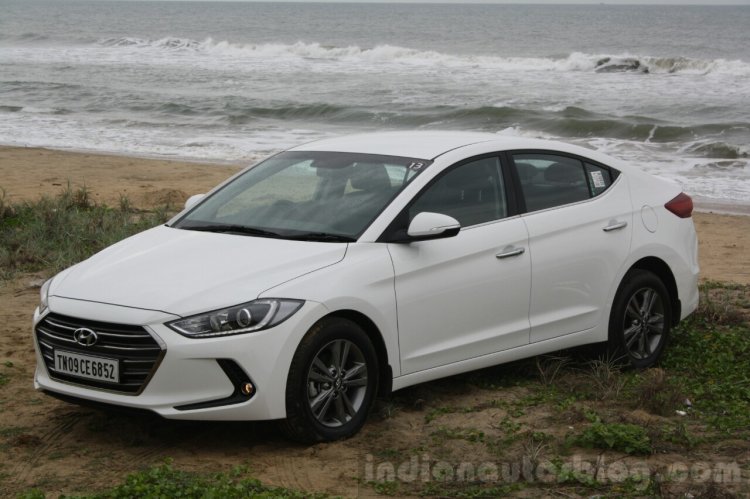
What the 2016 Hyundai Elantra has going for it are excellent space and comfort, good build quality, decent feature list coupled with an attractive exterior. The petrol engine doesn't feel all that enthusiastic or nice to drive as the competition, whereas the diesel variants (MT and AT) strike a fine balance between fuel efficiency and drivability.
However, if you're a buyer primarily looking at rear seat comfort with the occasional self-drive, the 2016 Elantra comes across as highly recommended; comfort is the Elantra's forte and Hyundai has priced it rather well in that aspect. We would go on to say that the Elantra is the most comfortable sedan in this segment, especially at the rear.



























































